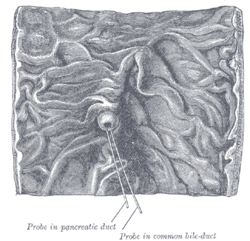- Circular folds
-
Circular folds 
Interior of the descending portion of the duodenum, showing the Major duodenal papilla. Latin plicae circulares Gray's subject #248 1173 The circular folds (valves of Kerckring) (also, plicae circulares / valvulae conniventes) are large valvular flaps projecting into the lumen of the bowel.
Contents
Composition
They are composed of reduplications of the mucous membrane, the two layers of the fold being bound together by submucous tissue.
Difference from other gastrointestinal folds
Unlike the folds in the stomach, they are permanent, and are not obliterated when the intestine is distended.
The space between circular folds are smaller than the haustra of the colon, and, in contrast to haustra, circular folds reach around the whole circumference of the intestine. These differences can assist in distinguishing the small intestine from the colon on an abdominal x-ray.
Location
The majority extend transversely around the cylinder of the small intestine for about one-half or two-thirds of its circumference, but some form complete circles, and others have a spiral direction; the latter usually extend a little more than once around the bowel, but occasionally two or three times.
Size
The larger folds are about 8 mm. in depth at their broadest part; but the greater number are of smaller size.
The larger and smaller folds alternate with each other.
Distribution
They are not found at the commencement of the duodenum, but begin to appear about 2.5 or 5 cm. beyond the pylorus.
In the lower part of the descending portion, below the point where the bile and pancreatic ducts enter the small intestine, they are very large and closely approximated.
In the horizontal and ascending portions of the duodenum and upper half of the jejunum they are large and numerous, but from this point, down to the middle of the ileum, they diminish considerably in size.
In the lower part of the ileum they almost entirely disappear; hence the comparative thinness of this portion of the intestine, as compared with the duodenum and jejunum.
Function
The circular folds slow the passage of the food along the intestines, and afford an increased surface for absorption. They are covered with small fingerlike projections called villi (singular, villus). Each villus, in turn, is covered with microvilli. The microvilli absorb fats and nutrients from the chyme.
External links
- SUNY Labs 39:12-0302 - "Intestines and Pancreas: The Jejunum and the Ileum"
- Diagram at Clarion University of Pennsylvania
This article was originally based on an entry from a public domain edition of Gray's Anatomy. As such, some of the information contained within it may be outdated.
Categories:- Digestive system
- Digestive system stubs
Wikimedia Foundation. 2010.
